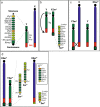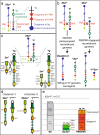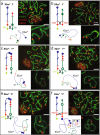Recombination between the mouse Y chromosome short arm and an additional Y short arm-derived chromosomal segment attached distal to the X chromosome PAR
- PMID: 26596988
- PMCID: PMC4830887
- DOI: 10.1007/s00412-015-0559-0
Recombination between the mouse Y chromosome short arm and an additional Y short arm-derived chromosomal segment attached distal to the X chromosome PAR
Abstract
In a male mouse, meiosis markers of processed DNA double strand breaks (DSBs) such as DMC1 and RAD51 are regularly seen in the non-PAR region of the X chromosome; these disappear late in prophase prior to entry into the first meiotic metaphase. Marker evidence for DSBs occurring in the non-PAR region of the Y chromosome is limited. Nevertheless, historically it has been documented that recombination can occur within the mouse Y short arm (Yp) when an additional Yp segment is attached distal to the X and/or the Y pseudoautosomal region (PAR). A number of recombinants identified among offsprings involved unequal exchanges involving repeated DNA segments; however, equal exchanges will have frequently been missed because of the paucity of markers to differentiate between the two Yp segments. Here, we discuss this historical data and present extensive additional data obtained for two mouse models with Yp additions to the X PAR. PCR genotyping enabled identification of a wider range of potential recombinants; the proportions of Yp exchanges identified among the recombinants were 9.7 and 22.4 %. The frequency of these exchanges suggests that the Yp segment attached to the X PAR is subject to the elevated level of recombinational DSBs that characterizes the PAR.
Keywords: Meiosis; Mouse; Recombination; Short arm (Yp); Spo11; Y-chromosome.
Figures




Similar articles
-
Meiosis reveals the early steps in the evolution of a neo-XY sex chromosome pair in the African pygmy mouse Mus minutoides.PLoS Genet. 2020 Nov 12;16(11):e1008959. doi: 10.1371/journal.pgen.1008959. eCollection 2020 Nov. PLoS Genet. 2020. PMID: 33180767 Free PMC article.
-
Exchange of terminal portions of X- and Y-chromosomal short arms in human XX males.Nature. 1987 Jul 30-Aug 5;328(6129):437-40. doi: 10.1038/328437a0. Nature. 1987. PMID: 2886915
-
Instability of the Pseudoautosomal Boundary in House Mice.Genetics. 2019 Jun;212(2):469-487. doi: 10.1534/genetics.119.302232. Epub 2019 Apr 26. Genetics. 2019. PMID: 31028113 Free PMC article.
-
X-Y translocations and sex differentiation.Semin Reprod Med. 2001 Jun;19(2):133-9. doi: 10.1055/s-2001-15393. Semin Reprod Med. 2001. PMID: 11480910 Review.
-
The pseudoautosomal regions of the human sex chromosomes.Hum Genet. 1993 Oct;92(4):315-24. doi: 10.1007/BF01247327. Hum Genet. 1993. PMID: 8225310 Review.
Cited by
-
Special issue on "recent advances in meiotic chromosome structure, recombination and segregation".Chromosoma. 2016 Jun;125(2):173-5. doi: 10.1007/s00412-016-0586-5. Epub 2016 Mar 29. Chromosoma. 2016. PMID: 27022980 No abstract available.
References
Publication types
MeSH terms
Grants and funding
LinkOut - more resources
Full Text Sources
Other Literature Sources
Molecular Biology Databases
Research Materials

